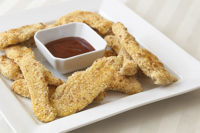Adding Value With Batters and Breadings
By Lisa White
New flavor profiles, innovative technology and healthier options are benefitting the batter and breading segments.
With today’s emphasis on healthy eating, one would think battered and breaded proteins, which are typically fried, would not be big sellers these days.
However, many are finding the opposite is true. There has been a notable increase in foodservice operators’ appetizer programs, culminating in more breaded poultry items, in particular. In addition, with convenience becoming the biggest factor in people’s dinner decision-making, breaded pork, country-fried steak and other easily baked-off items are now at the forefront.
“There has been a steady increase in coatings each year,” says George Kelecich, director of product development at Chicago-based Newly Weds Foods. “People think sales will fall off due to healthy eating trends, but they haven’t. Instead, people are looking for even more innovations in this segment. As a result, we can make a coating almost any way that it’s needed.”
According to Paul Ludtke, director of research and development at Kerry Ingredients, based in Beloit, Wis., batter and breading add value to proteins by creating a new product category. “It creates something that is different both in visual and textural appeal than the meat by itself,” he says. “Also, batter and breading affects the cost of the item because, in many cases, batter and breading costs less than the protein, resulting in a lower cost to the finished product.”
Ron Ratz, director of protein development at Wixon Inc. in St. Francis, Wis., agrees, saying that, from a value-added perspective, many companies are seeing the benefits of incorporating battered and breaded proteins.
Given the various ingredient types, the process is more scientific than many would think. Kelecich says there are different ways of baking the various types of breads used for breading to get the many textures, looks and densities that these products require. “From our standpoint, we work with texture, appearance and the way products are fried,” he says.
These days, companies also are getting more creative with flavor profiles, textures and the unique product varieties. “Processors can get creative, using whole-muscle and ground or emulsified product as the protein source,” Ratz says.
While in the past, emulsified formed protein was a popular source for these products, this is changing. “The snacking trend at both the retail and foodservice levels has allowed us to look beyond emulsification. For example, ground meat such as sausage and bratwurst is battered and breaded and is becoming more popular,” Ratz says.
The batter and breading process varies, depending on the product. Protein is formed first, with seasonings and flavors incorporated using a marination or injection process. If it is a whole-muscle meat, it is typically injected with flavor or vacuum tumbled with marinade prior to breading. Chopped or formed meat incorporates seasonings and spices before batter and breading.
Predusting sets the stage for the rest of the coating and acts as a major flavor carrier, Ludtke says. “There are a lot of different combinations in this process. For example, some products may just have a predust and batter. But generally most meat and poultry are predusted, battered and then breaded,” he explains.
Flavors & textures
Many say this category is defined by the top-selling flavors and textures. “We are always working on developing coating systems for battered and breaded products that showcases the latest flavor trends,” Ludtke says, adding that the most prevalent new flavor requests are for Pan Asian, Moroccan and Latin American flavor profiles.
With consumers becoming more adventurous, food savvy and educated, the demand for ethnic flavors is on the rise. “In general, we’re finding hot, smoky, heat and savory flavors are not going away. Traditional flavor systems, like spicy, remain popular,” Ratz says. “But people have more adventurous taste buds. As a result, Mediterranean, Moroccan and Latin flavors are emerging. Island cuisine profiles also have become more popular, including Hawaiian, Jamaican, Caribbean and Cuban.”
In addition, regional cuisine has had an impact on the batter and breading segment. Ratz notes that bratwurst, a Wisconsin specialty, is being breaded with grilled onion flavor coatings. “As flavor systems grow, we are finding more synergies with protein,” he says.
Batters are more straightforward, although Ratz sees an increased interest in pretzel batter.
Orest Hanas, manager of foodservice innovation at McCormick & Co., located in Hunt Valley, Md., says he sees increasing interest in cheese-flavored coating systems. “This is because the technology for these flavors is improving. In the past, they would burn off in the fryer, but now processed flavors and enzyme modification has made delicate flavors more robust and able to withstand abusive fryer temperatures,” he says.
From a textural standpoint, there have been attempts to create breading that absorbs less oil to create products with better nutritional profiles. “The focus is on heat-resistant flavors, and there have been advances in that area,” Hanas says.
Technological developments in the batter and breading area also focus on creating more healthful products. “In terms of technology, companies are trying to come up with more crispy or crunchy textures, extended hold times and natural or reduced fat lines. Those are the things we are working on,” Ludtke says.
Prolonging shelf life also is a priority at Wixon. According to Ratz, the company has developed a fat stabilization system for deep fat frying that reduces the off flavor associated with oxidization. “We worked on a project that had a pre-cooked emulsified battered and breaded product sold refrigerated or frozen. The shelf life from an oxidative flavor standpoint contained off notes. We realized it was the oil from the coating, and not the protein, that was oxidizing and decreasing the shelf life flavor profile. Consequently, we ran tests using an antioxidant system in the breading and batter and were able to obtain increased shelf life for par fried or fried products,” he says.
A healthy spin
With healthful product development at the forefront, increased challenges ensue. Ludtke says the increased focus on natural products affects the use of functional ingredients that help provide better textures and product performance. “We are always looking at that and trying to overcome it. We have to find ways to replace functional ingredients with natural ingredients. Sometimes there is a trade off, but this segment will always be influenced by flavor and texture,” he says.
Another challenge is creating low-fat options that have the same taste profile as traditional products. “The health benefits of a low-fat product will be offset if it doesn’t taste like it is fully fried,” Ludtke says. “In addition, if we develop phenomenal multi-grain and whole-wheat systems that customers aren’t receptive to, it is hard for people to get over that. These changes are slow to catch on with consumers.”
Jerry Hall, CEO at Pekin, Ill.-based Excalibur Seasoning Co. says his company has had good results switching from enriched wheat flour to whole wheat breading. “Whole wheat looks good on a label, so our customers want us to get further into it. We also are playing around with Omega 3. We have a line in this segment that is doing well. We add Omega 3 ingredients like barley to 50 percent of the breading,” he says.
Ratz predicts there will be more natural battered and breaded products in the coming years. “This may pose a challenge for the industry, but it is important to remember that natural is different from organic. While organic products are subject to certain regulations and guidelines, natural products are not. There are a growing number of companies providing raw materials that are all-natural, so we have options,” he says.
Natural ingredients also are more costly to procure and more expensive to produce, Kelecich says. “Still, the trend is toward healthier products. More items are trans fat free and have reduced salt. Companies use salt replacers to reduce sodium and different oils that reduce trans fat. This can affect product shelf life, depending on the product,” he says.
According to Hanas, trans fat is the biggest issue currently in the fried foods segment. “This comes mostly from the frying oil than the breading, although we can help minimize oil absorption,” he says, noting there is newer technology in the starch and gum area that helps make breading more resistant to oil absorption.
He agrees that there tends to be a loss of functionality when changes are made for nutritional benefits. “Creating more nutritional products involves more expensive ingredients and more sophisticated equipment. The technology is there and we have the capability to do this, but it costs more money,” Hanas explains.
Ratz predicts more natural battered and breaded products in the future for both baked and fried applications. “As an organically certified supplier, we have seen an increase in the demand regarding natural formulations,” he says.
The future in batters and breadings depends on what is in demand from a trends standpoint, says Kelecich. “Customization will be key. If processors want it, we will find a way to make it happen. The industry will continue developing flavor and meal systems that work together,” he says.


Report Abusive Comment